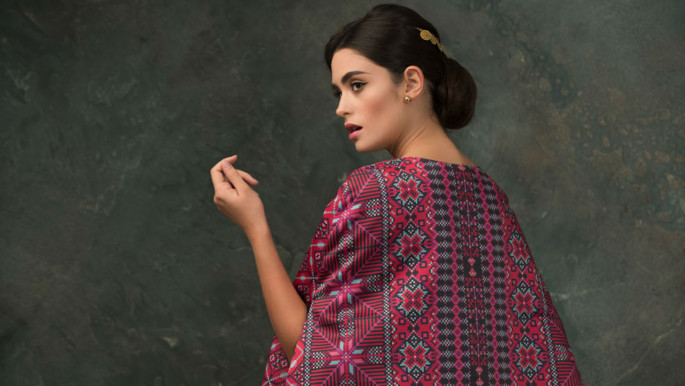Inside the origins and evolution of traditional Palestinian costume
In recent years, Palestinian history has been making inroads in sustaining the people's memory. Oral history is being revived in academia, memory projects and activism. Juxtaposed against Palestinian culture and traditions, the vibrant picture of Palestine is gaining momentum.
Hanan Karaman Munayyer's recent book, Traditional Palestinian Costume. Origins and Evolution (Interlink Books, 2020) shows a history that is often overlooked, and from voices that are marginalised.
The Palestinian right to land and representation is depicted in the embroidery of Palestinian costumes – a skill which Palestinian women have mastered and which stands as testimony to the Palestinian people's heritage and land rights.
The Munayyer collection, which dates back to the 1850s, started as a project in the 1980s with a traditional embroidered dress bought from Jerusalem.
 |
Palestinian embroidered costume has transcended its role as a symbol of tradition to become a symbol of Palestinian identity |  |
The collection of textile arts expanded, as did the appreciation of the history behind the embroidery, tracing links to geographical regions of Palestine and the manner in which Palestinian embroidery also influenced European styles – a trend which also has historical roots in the Crusades, for example.
The trade route also played a role in influencing European embroidery, as did the printed book trade. By the 14th century, Palestine has established its traditional embroidery style. The books discusses recurring patterns found on the dresses, some of which have survived since medieval times.
Munayyer writes, "Palestinian embroidered costume has transcended its role as a symbol of tradition to become a symbol of Palestinian identity."
 |
| Read also: Weaving Palestinian heritage into contemporary fashion |
During the Nakba, when Palestinians fled their homes as a result of the Zionist ethnic cleansing and massacres, the Palestinian traditional costume was among the prized possessions which displaced families brought with them into exile.
To alleviate their financial hardship, Palestinian women sold their embroidered dresses. One dress in the Munayyer collection belonged to a woman from the Galilee, who sold her own wedding dress for just 7 dinars.
The Palestinian diaspora is likely replete with similar narratives. "Some of the rarest dresses in the collection come from these sales," the book attests, with reference to the post-Nakba era.
A similar pattern of sales was repeated in 1967, when the next Palestinian exodus happened after the Six-Day War which resulted in the Israeli military occupation of Palestine.
 |
Munayyer's discussion of the Palestinian costume in Ramallah is particularly insightful, showing how the upheaval in politics due to colonisation and displacement was reflected in the evolution of Palestinian dress |  |
Due to displacement, tracking down the origins of embroidered patterns proved to be a meticulous task.
Some patterns used date back centuries and share similarities with other Arab embroidery patterns. The Palestinian embroidery features symbols such as the Christian cross, palm trees, stairs, diamonds, flower rosettes and birds, among many others. Each symbol pertains to a different Palestinian region and points towards tradition and folklore.
Through full colour photography, the book details traditional Palestinian costume by regions and cities, writing a history of Palestine through the intricate needlework. It discusses how the white thobe was the most popular with visitors purchasing costumes to take back as gifts or keepsakes.
Munayyer's discussion of the Palestinian costume in Ramallah is particularly insightful, showing how the upheaval in politics due to colonisation and displacement was reflected in the evolution of Palestinian dress.
The influx of refugees to Ramallah post-1948 resulted in an array of different patterns that can be traced back to the original villages.
 |
The embroidery weaves its own story, against a backdrop of violent dispossession which needs to be resisted by all means |  |
Likewise, Munayyer shows the similarities between Ramallah, Jerusalem and Emmaus in terms of embroidery, while Beit Dajan shares traits with Jaffa. The author also notes that while religious patterns were embroidered on dresses, the Palestinian identity prevailed over faith, thus strengthening the collective history and memory.
Gaza, on the other hand, is marked by post-Nakba poverty which is reflected in the less intricate embroidery of its Palestinian dress.
From the 1960s onwards, Palestinian embroidery retained its traditional style while incorporating different patterns. In the context of a population which has become permanently displaced, the traditional Palestinian costume has also become part of organised workshops that promote Palestinian heritage while also providing an income, due worldwide demand.
Read more: When dancing could mean life and death: How one Palestinian troupe is resisting Israeli occupation
A history of Palestine through embroidery, this is a book not to be missed. The collection challenges Palestine's erasure as a result of the dominant, and fabricated, Zionist narratives.
Moreover, the book is a valuable addition to the sources which document the forgotten, or marginalised, Palestinian historical narratives.
The embroidery weaves its own story, against a backdrop of violent dispossession which needs to be resisted by all means, including disseminating the stories of overlooked Palestinian history.
Ramona Wadi is an independent researcher, freelance journalist, book reviewer and blogger specialising in the struggle for memory in Chile and Palestine, colonial violence and the manipulation of international law.
Follow her on Twitter here: @walzerscent




 Follow the Middle East's top stories in English at The New Arab on Google News
Follow the Middle East's top stories in English at The New Arab on Google News


